Planning for Success and Security – Providing Assistance Without a Back-Up Plan Puts Everyone at Risk

A town manager in Maine had suddenly found himself in charge of his small community water system. The small town’s water operator had suddenly taken ill and was hospitalized. The back-up operator had passed away six months ago. Unfortunately, this avoidable story is not uncommon.
The community was quite remote, and the town manager was in desperate need of an operator who could help keep their two treatment plants operational. The system has several treatment phases including pre-chlorination, filtration, aeration, and fluoridation that need to be monitored and maintained. Several days and several frantic calls later, they were connected to a licensed contract operator who was willing to drive the two hours to investigate the situation.
Upon arrival, the contract operator was greeted by a public works employee who was set to be cross-trained in the water department but had no working knowledge of the treatment plants. The public works employee confessed that the regular operator, now hospitalized, had told him that the information was “all up here” as he pointed to his brain. It seemed the hospitalized operator had felt his job was threatened and closely guarded the operational information. That fear, which is often shared by undervalued operators, is unfortunate, as it created a stressful situation for everyone left in his wake.
By the end of day one, the contract operator and the public works employee were able to determine where the maintenance logs and the test kits were located. The contract operator was successfully able to show the public works employee how to run the daily tests and record the meter readings. Then the contract operator began searching for the operation and maintenance (O&M) manual or any standard operating procedures (SOPs), to figure out how the system worked, but to no avail. There were no clear procedures found to follow to ensure the system was running properly. Under stacks of unfiled paperwork, the contract operator was able to find an emergency response plan that hadn’t been updated in 18 years, which is recommended to be updated annually, but it had very little detail and was of little help. With the assistance of contract operator’s administrative office, they were able to piece together clues as to how the facilities operated through state records and other pieces of information.
By day two, alarms began to sound, though no one really knew that alarms were sounding, as the hospitalized operator was the only one getting the notifications. It was upon arrival to the plant that the public works employee observed the chlorine feed tank had run dry. The proper ratio to prepare the chlorine solution was unknown. The fluoride pump appeared to be unplugged. The public works employee was untrained in how to properly handle these dangerous chemicals. The contract operator stepped in again to help batch the chemicals and get the chemical feeds pumping. The contract operator’s best recourse and advice was to encourage the town manager and the public works employee to reach out to their regular operator, while in the hospital, to get guidance. This was not an ideal situation for anyone.
This emergency could have been avoided and continuity in service could have easily been maintained by having an O&M manual readily available. The O&M manual serves not only as a tool for the operation and maintenance of the facilities for the personnel of the plant; but it also serves as a road map for those who must step in when the primary operations crew is unavailable. For the manual to be effective, vital information must be easy to find, quickly and efficiently. The O&M manual is designed to provide treatment system personnel and the back-up operator the proper understanding of techniques and reference protocols necessary to efficiently operate their facilities. Having an O&M manual which includes well written SOPs and an emergency response plan will ensure that operations will be continued in a situation when new or temporary staff must be trained quickly.
Moving forward, the contract operator has been retained as the town’s back-up operator. His crew has already begun planning to assist with the development of a functional O&M manual to avoid this situation in the future. The grateful town manager is now keenly aware of the need to document everything and to have a back-up plan in place.
When developing an O&M manual, you should ask yourself:
- What do I do on a daily and weekly basis to maintain my water and/or wastewater treatment system?
- Do these activities or pieces of equipment that need maintenance involve SOPs, manufacturer’s specifications, or record keeping logs?
- Do I have the right tools?
- What documents or logs do I need to develop?
“Thank you so much for the help you guys have provided. You have been wonderful to work with. We will certainly be in touch.” – Town Manager of a Little Town, Maine, USA



